
Hyponome
Encyclopedia
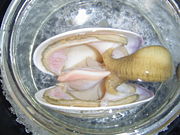
Class (biology)
In biological classification, class is* a taxonomic rank. Other well-known ranks are life, domain, kingdom, phylum, order, family, genus, and species, with class fitting between phylum and order...
es: Gastropoda
Gastropoda
The Gastropoda or gastropods, more commonly known as snails and slugs, are a large taxonomic class within the phylum Mollusca. The class Gastropoda includes snails and slugs of all kinds and all sizes from microscopic to quite large...
, Bivalvia
Bivalvia
Bivalvia is a taxonomic class of marine and freshwater molluscs. This class includes clams, oysters, mussels, scallops, and many other families of molluscs that have two hinged shells...
and Cephalopoda. In other words, a siphon is found in some saltwater and freshwater snail
Snail
Snail is a common name applied to most of the members of the molluscan class Gastropoda that have coiled shells in the adult stage. When the word is used in its most general sense, it includes sea snails, land snails and freshwater snails. The word snail without any qualifier is however more often...
s, in some clams
CLaMS
CLaMS is a modular chemistry transport model system developed at Forschungszentrum Jülich, Germany. CLaMS was first described by McKenna et al. and was expanded into three dimensions by Konopka et al....
, and in octopus
Octopus
The octopus is a cephalopod mollusc of the order Octopoda. Octopuses have two eyes and four pairs of arms, and like other cephalopods they are bilaterally symmetric. An octopus has a hard beak, with its mouth at the center point of the arms...
, squid
Squid
Squid are cephalopods of the order Teuthida, which comprises around 300 species. Like all other cephalopods, squid have a distinct head, bilateral symmetry, a mantle, and arms. Squid, like cuttlefish, have eight arms arranged in pairs and two, usually longer, tentacles...
and relatives.
Siphons in molluscs are tube-like structures in which water flows (or more rarely in which air flows). The water flow is used for one or more purposes such as locomotion
Animal locomotion
Animal locomotion, which is the act of self-propulsion by an animal, has many manifestations, including running, swimming, jumping and flying. Animals move for a variety of reasons, such as to find food, a mate, or a suitable microhabitat, and to escape predators...
, feeding
Feeding
Feeding is the process by which organisms, typically animals, obtain food. Terminology often uses either the suffix -vore from Latin vorare, meaning 'to devour', or phagy, from Greek φαγειν, meaning 'to eat'.-Evolutionary history:...
, respiration
Respiration (physiology)
'In physiology, respiration is defined as the transport of oxygen from the outside air to the cells within tissues, and the transport of carbon dioxide in the opposite direction...
, and reproduction. The siphon is part of the mantle
Mantle (mollusc)
The mantle is a significant part of the anatomy of molluscs: it is the dorsal body wall which covers the visceral mass and usually protrudes in the form of flaps well beyond the visceral mass itself.In many, but by no means all, species of molluscs, the epidermis of the mantle secretes...
of the mollusc, and the water flow is directed to (or from) the mantle cavity.
A single siphon occurs in some gastropods. In those bivalves which have siphons, the siphons are paired. In cephalopods, there is a single siphon or funnel which is known as a hyponome
Hyponome
A siphon is an anatomical structure which is part of the body of aquatic molluscs in three classes: Gastropoda, Bivalvia and Cephalopoda. In other words, a siphon is found in some saltwater and freshwater snails, in some clams, and in octopus, squid and relatives.Siphons in molluscs are tube-like...
.
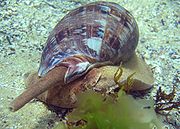
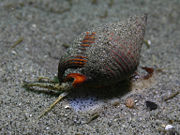
In gastropods
In some (but not all) sea snailSnail
Snail is a common name applied to most of the members of the molluscan class Gastropoda that have coiled shells in the adult stage. When the word is used in its most general sense, it includes sea snails, land snails and freshwater snails. The word snail without any qualifier is however more often...
s, marine
Marine (ocean)
Marine is an umbrella term. As an adjective it is usually applicable to things relating to the sea or ocean, such as marine biology, marine ecology and marine geology...
gastropod molluscs, the animal has an anterior extension of the mantle
Mantle (mollusc)
The mantle is a significant part of the anatomy of molluscs: it is the dorsal body wall which covers the visceral mass and usually protrudes in the form of flaps well beyond the visceral mass itself.In many, but by no means all, species of molluscs, the epidermis of the mantle secretes...
called a siphon, or inhalant siphon, through which water is drawn into the mantle cavity and over the gill for respiration.
This siphon is a soft fleshy tube-like structure equipped with chemoreceptors which "smell" or "taste" the water, in order to hunt for food. Marine gastropods that have a siphon are either predators or scavengers.
Although in gastropods the siphon functions perfectly well as a tube, it is not in fact a hollow organ, it is simply a flap of the mantle that is rolled into the shape of a tube.
In many marine gastropods where the siphon is particularly long, the structure of the shell
Gastropod shell
The gastropod shell is a shell which is part of the body of a gastropod or snail, one kind of mollusc. The gastropod shell is an external skeleton or exoskeleton, which serves not only for muscle attachment, but also for protection from predators and from mechanical damage...
has been modified in order to house and protect the soft tissue of the siphon. This shell modification is known as the siphonal canal
Siphonal canal
Some sea marine gastropods have a soft tubular anterior extension of the mantle called a siphon through which water is drawn into the mantle cavity and over the gill and which serves as a chemoreceptor to locate food. In many carnivorous snails, where the siphon is particularly long, the structure...
. For a gastropod whose shell
Gastropod shell
The gastropod shell is a shell which is part of the body of a gastropod or snail, one kind of mollusc. The gastropod shell is an external skeleton or exoskeleton, which serves not only for muscle attachment, but also for protection from predators and from mechanical damage...
has an exceptionally long siphonal canal, see Venus comb murex
Venus Comb Murex
The Venus comb murex, scientific name Murex pecten, is a species of large predatory sea snail, a marine gastropod mollusk in the family Muricidae, the rock snails or murex snails....
.
In the case of some other marine gastropod shells, such as the volute and the Nassarius pictured above, the shell has a simple "siphonal notch" at the anterior edge of the aperture
Aperture (mollusc)
The aperture is an opening in certain kinds of mollusc shells: it is the main opening of the shell, where part of the body of the animal emerges for locomotion, feeding, etc....
instead of a long siphonal canal.
The Aplysia gill and siphon withdrawal reflex
Aplysia gill and siphon withdrawal reflex
The Aplysia gill and siphon withdrawal reflex is an involuntary, defensive reflex of the sea hare Aplysia californica, a large shell-less sea snail or sea slug...
is a defensive reflex
Reflex
A reflex action, also known as a reflex, is an involuntary and nearly instantaneous movement in response to a stimulus. A true reflex is a behavior which is mediated via the reflex arc; this does not apply to casual uses of the term 'reflex'.-See also:...
which is found in sea hares of the genus Aplysia
Aplysia
Aplysia is a genus of medium-sized to extremely large sea slugs, specifically sea hares, which are one clade of large sea slugs, marine gastropod mollusks. The general description of sea hares can be found in the article on the superfamily Aplysioidea....
; this reflex has been much studied in neuroscience
Neuroscience
Neuroscience is the scientific study of the nervous system. Traditionally, neuroscience has been seen as a branch of biology. However, it is currently an interdisciplinary science that collaborates with other fields such as chemistry, computer science, engineering, linguistics, mathematics,...
.
Siphon as a snorkel

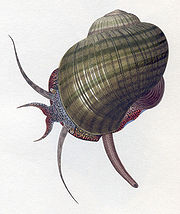
Pomacea
Pomacea is a genus of freshwater snails with gills and an operculum, aquatic gastropod mollusks in the family Ampullariidae. As Pomacea or sometimes incorrectly Ampullarius it is commonly sold as "[color] mystery snail" in aquariums in the United States.- Species :Species in the genus Pomacea...
and Pila have an extensible siphon made from a flap of the left mantle cavity. They use this siphon in order to breathe air while they are submerged in water which has a low oxygen content so they cannot effectively use their gill.
Apple snails use the siphon in a way that is reminiscent of a human swimmer using a snorkel, except that the apple snail's siphon can be retracted completely, or extended to various lengths as needed.
For these freshwater snails, the siphon is an anti-predator adaptation. It reduces their vulnerability to being attacked and eaten by birds because it enables the apple snails to breathe without having to come all the way up to the surface, where they are easily visible to predators.
The shells of these freshwater snails have simple round apertures
Aperture (mollusc)
The aperture is an opening in certain kinds of mollusc shells: it is the main opening of the shell, where part of the body of the animal emerges for locomotion, feeding, etc....
; there is no special notch for the siphon.
Paired siphons of bivalves
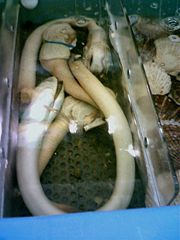


Substrate (biology)
In biology a substrate is the surface a plant or animal lives upon and grows on. A substrate can include biotic or abiotic materials and animals. For example, encrusting algae that lives on a rock can be substrate for another animal that lives on top of the algae. See also substrate .-External...
, as is the case in scallop
Scallop
A scallop is a marine bivalve mollusk of the family Pectinidae. Scallops are a cosmopolitan family, found in all of the world's oceans. Many scallops are highly prized as a food source...
s, oyster
Oyster
The word oyster is used as a common name for a number of distinct groups of bivalve molluscs which live in marine or brackish habitats. The valves are highly calcified....
s, etc, do not need them. Only those bivalves that burrow in sediment
Sediment
Sediment is naturally occurring material that is broken down by processes of weathering and erosion, and is subsequently transported by the action of fluids such as wind, water, or ice, and/or by the force of gravity acting on the particle itself....
, and live buried in the sediment, need to use these tube-like structures. The function of these siphons is to reach up to the surface of the sediment, so that the animal is able to respire, feed, and excrete, and also to reproduce.
The deeper a bivalve species lives in the sediment, the longer its siphons are. Bivalves which have extremely long siphons, like the Geoduck
Geoduck
The geoduck , Panopea generosa, is a species of very large saltwater clam, a marine bivalve mollusk in the family Hiatellidae.The shell of this clam is large, about to over in length, but the very long siphons make the clam itself very much longer than this: the "neck" or siphons alone can be ...
s pictured here, live very deeply buried, and are hard to dig up when clamming.

The bivalve's two siphons are situated at the posterior edge of the mantle cavity. There is an inhalant or incurrent siphon, and an exhalant or excurrent siphon. The water is circulated by the action of the gill
Gill
A gill is a respiratory organ found in many aquatic organisms that extracts dissolved oxygen from water, afterward excreting carbon dioxide. The gills of some species such as hermit crabs have adapted to allow respiration on land provided they are kept moist...
s. Usually water enters the mantle cavity through the inhalant siphon, moves over the gills, and leaves through the exhalant siphon. The water current is utilized for respiration, but also for filter feeding, excretion
Excretion
Excretion is the process by which waste products of metabolism and other non-useful materials are eliminated from an organism. This is primarily carried out by the lungs, kidneys and skin. This is in contrast with secretion, where the substance may have specific tasks after leaving the cell...
, and reproduction.
Feeding
Depending on the species and family concerned, some bivalves utilize their inhalant siphon like the hose of a vacuum cleaner, and actively suck up food particles from the marine substrateSubstrate (biology)
In biology a substrate is the surface a plant or animal lives upon and grows on. A substrate can include biotic or abiotic materials and animals. For example, encrusting algae that lives on a rock can be substrate for another animal that lives on top of the algae. See also substrate .-External...
. Most other bivalves ingest microscopic phytoplankton as food from the general water supply, which enters via the inhalant siphon and reaches the mouth after passing over the gill.
Please also see pseudofeces
Pseudofeces
Pseudofeces or pseudofaeces are a way that filter-feeding bivalve mollusks get rid of suspended particles which have been rejected as unsuitable for food. The rejected particles are wrapped in mucus, and are expelled without having passed through the digestive tract...
.
Hyponome of cephalopods
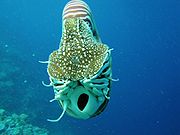
Cephalopod
A cephalopod is any member of the molluscan class Cephalopoda . These exclusively marine animals are characterized by bilateral body symmetry, a prominent head, and a set of arms or tentacles modified from the primitive molluscan foot...
s to expel water, a function that produces a locomotive force
Jet propulsion
Jet propulsion is motion produced by passing a jet of fluid in the opposite direction to the direction of motion. By conservation of momentum, the moving body is propelled in the opposite direction to the jet....
. The hyponome developed from the foot of the molluscan ancestor.
Water enters the mantle cavity around the sides of the funnel, and subsequent contraction of the hyponome expands and then contracts, expelling a jet of water.
In most cephalopods, such as octopus
Octopus
The octopus is a cephalopod mollusc of the order Octopoda. Octopuses have two eyes and four pairs of arms, and like other cephalopods they are bilaterally symmetric. An octopus has a hard beak, with its mouth at the center point of the arms...
, squid
Squid
Squid are cephalopods of the order Teuthida, which comprises around 300 species. Like all other cephalopods, squid have a distinct head, bilateral symmetry, a mantle, and arms. Squid, like cuttlefish, have eight arms arranged in pairs and two, usually longer, tentacles...
, and cuttlefish
Cuttlefish
Cuttlefish are marine animals of the order Sepiida. They belong to the class Cephalopoda . Despite their name, cuttlefish are not fish but molluscs....
, the hyponome is a muscular tube. The hyponome of the nautilus
Nautilus
Nautilus is the common name of marine creatures of cephalopod family Nautilidae, the sole extant family of the superfamily Nautilaceae and of its smaller but near equal suborder, Nautilina. It comprises six living species in two genera, the type of which is the genus Nautilus...
differs however, in that it is a one-piece flap that is folded over. Whether ammonite
Ammonite
Ammonite, as a zoological or paleontological term, refers to any member of the Ammonoidea an extinct subclass within the Molluscan class Cephalopoda which are more closely related to living coleoids Ammonite, as a zoological or paleontological term, refers to any member of the Ammonoidea an extinct...
s possessed a hyponome and if so what form it may have taken, is as yet not known.

